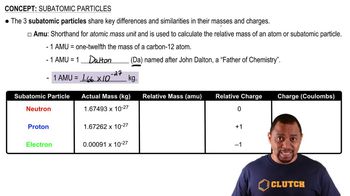Determine the energy of 1 mol of photons for each kind of light. (Assume three significant figures.) a. infrared radiation (1500 nm) b. visible light (500 nm) c. ultraviolet radiation (150 nm)
What happens to the interference pattern if we attempt to determine which slit the electron passes through using a laser placed directly behind the slits? Additionally, what happens to the interference pattern described in Problem 47 if the rate of electrons passing through the slits is reduced to one electron per hour?
 Verified step by step guidance
Verified step by step guidanceKey Concepts
Wave-Particle Duality

Quantum Measurement

Single Electron Interference

How much energy is contained in 1 mol of each? a. X-ray photons with a wavelength of 0.135 nm b. γ-ray photons with a wavelength of 2.15×10–5 nm
Sketch the interference pattern that results from the diffraction of electrons passing through two closely spaced slits.
The resolution limit of a microscope is roughly equal to the wavelength of light used in producing the image. Electron microscopes use an electron beam (in place of photons) to produce much higher resolution images, about 0.20 nm in modern instruments. Assuming that the resolution of an electron microscope is equal to the de Broglie wavelength of the electrons used, to what speed must the electrons be accelerated to obtain a resolution of 0.20 nm?
The smallest atoms can themselves exhibit quantum-mechanical behavior. Calculate the de Broglie wavelength (in pm) of a hydrogen atom traveling at 475 m/s.
